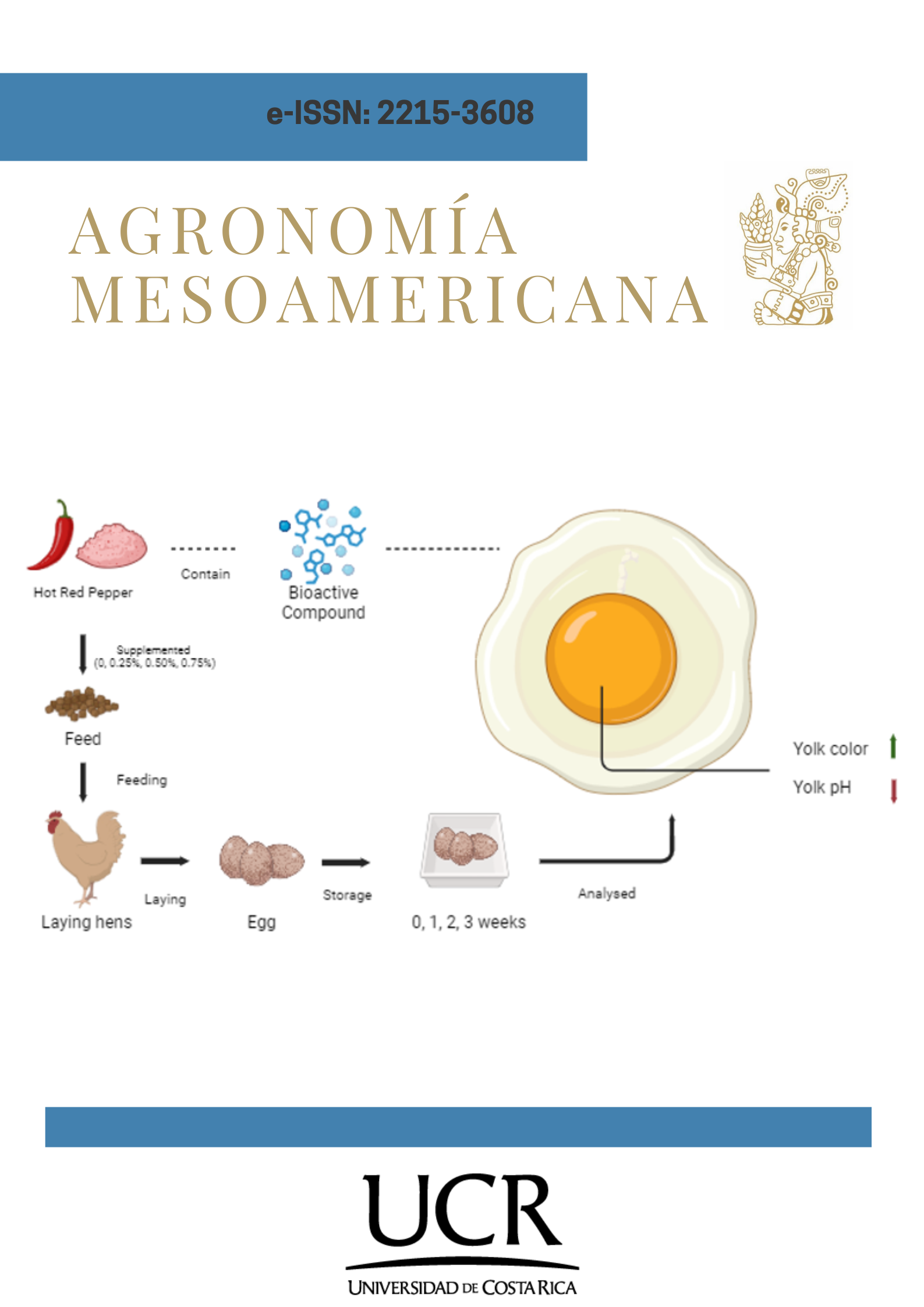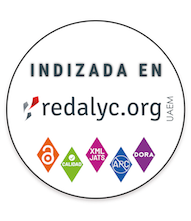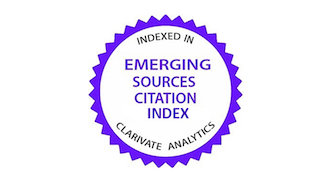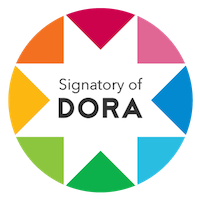Efecto de la suplementación con pimiento rojo picante y diferentes tiempos de almacenamiento sobre la calidad de los huevos de gallina
DOI:
https://doi.org/10.15517/am.2024.59760Palabras clave:
Capsicum annuum, alimentos para animales, producción de huevos, almacenamiento de alimentos, gallina ponedoraResumen
Introducción. Los huevos son un alimento fuente de proteínas que se deteriora fácilmente durante su almacenamiento. La suplementación de polvo de pimiento rojo picante rico en compuestos bioactivos en dietas para gallinas ponedoras puede mejorar la calidad del huevo y prevenir su deterioro durante el almacenamiento. Objetivo. Determinar el efecto de la suplementación con pimiento rojo picante en polvo y diferentes tiempos de almacenamiento sobre la calidad física del huevo de gallinas ponedoras. Materiales y métodos. El estudio se llevó a cabo de enero a marzo de 2024 en el Granero de Investigación de PT Agromix Lestari Group, Kulon Progo, Yogyakarta, Indonesia. Se asignaron 80 gallinas ponedoras de 56 semanas de edad (1681 ± 64 g) de la cepa Novogen a cuatro tratamientos dietéticos (cuatro réplicas, cinco gallinas por réplica): dieta basal como control (P0); dieta basal + 0,25 % de chile rojo en polvo (P1); dieta basal + 0,5 % de chile rojo en polvo (P2), y dieta basal + 0,75 % de chile rojo en polvo (P3). Al final de la sexta semana, se recogió un huevo por grupo y se analizó su calidad física en tres tratamientos de almacenamiento: fresco (S0), una semana de almacenamiento (S1) y dos semanas de almacenamiento (S2). Los datos de calidad de los huevos se analizaron con un diseño experimental factorial (4 × 3) utilizando el programa SPSS 26 (Chicago, IL, USA). Resultados. La suplementación con un 0,5% de pimiento rojo picante en polvo aumentó significativamente el peso del huevo. La adición de pimiento rojo picante y la duración del tratamiento afectaron significativamente al color de la yema del huevo. El grupo tratado con pimiento picante mostró un pH del albumen y la yema significativamente más bajo. Conclusiones. Se demostró que la suplementación de pimiento rojo picante en polvo en las dietas de gallinas ponedoras mejoró el color de la yema del huevo. La inclusión de 0,5 % en la ración fue capaz de mantener bajo el pH de la yema y el albumen.
Descargas
Citas
Abd El-Hack, M. E., El-Saadony, M. T., Elbestawy, A. R., Gado, A. R., Nader, M. M., Saad, A. M., El-Tahan, A. M., Taha, A. E., Salem, H. M., & El-Tarabily, K. A. (2022). Hot red pepper powder as a safe alternative to antibiotics in organic poultry feed: an updated review. Poultry Science, 101(4), Article 101684. https://doi.org/10.1016/j.psj.2021.101684
Abou-Elkhair, R., Ahmed, H. A., & Selim, S. (2014). Effects of black pepper (Piper nigrum), turmeric powder (Curcuma longa) and coriander seeds (Coriandrum sativum) and their combinations as feed additives on growth performance, carcass traits, some blood parameters and humoral immune response of broiler chickens. Asian-Australasian Journal of Animal Sciences, 27(6), Article 847. https://doi.org/10.5713/ajas.2013.13644
Abou-Elkhair, R., Selim, S., & Hussein, E. (2018). Effect of supplementing layer hen diet with phytogenic feed additives on laying performance, egg quality, egg lipid peroxidation and blood biochemical constituents. Animal Nutrition, 4(4), 394–400. https://doi.org/10.1016/j.aninu.2018.05.009
Agma Okur, A., & Unver Kayhan, E. (2019). Impacts of red pepper supplemented diets and different storage conditions on eggs obtained from free-range laying hens. South African Journal of Animal Science, 48(5), Article 987. https://doi.org/10.4314/sajas.v48i5.19
Akter, Y., Kasim, A., Omar, H., & Sazili, A. Q. (2014). Effect of storage time and temperature on the quality characteristics of chicken eggs. Journal of Food, Agriculture and Environment, 12(3-4), 87–92.
Alam, M. A., Saleh, M., Mohsin, G. M., Nadirah, T. A., Aslani, F., Rahman, M. M., Roy, S. K., Juraimi, S. S., & Alam, M. Z. (2020). Evaluation of phenolics, capsaicinoids, antioxidant properties, and major macro-micro minerals of some hot and sweet peppers and ginger land-races of Malaysia. Journal of Food Processing and Preservation, 44(6), Article e14483. https://doi.org/10.1111/jfpp.14483
Al-matani, S. K., Al-Wahaibi, R. N. S., & Hossain, M. A. (2015). In vitro evaluation of the total phenolic and flavonoid contents and the antimicrobial and cytotoxicity activities of crude fruit extracts with different polarities from Ficus sycomorus. Pacific Science Review A: Natural Science and Engineering, 17(3), 103-108. https://doi.org/10.1016/j.psra.2016.02.002
Anas, M. A., Agus, A., Hanim, C., Babikian, H. J., & Jiaravanon, B. (2019). The effect of BAV addition as feed additive in laying hen ration on quality and chemical composition of egg. IOP Conference Series: Earth and Environmental Science, 387(1), Article 012090. https://doi.org/10.1088/1755-1315/387/1/012090
Balenović, M., Savić, V., Janječić, Z., Popović, M., Šimpraga, B., Carović-Stanko, K., Bedeković, D., & Amšel Zelenika, T. (2018). Immunomodulatory and antimicrobial effects of selected herbs on laying hens. Veterinarski Arhiv, 88(5), 673–686. https://doi.org/10.24099/vet.arhiv.0104
Boka, J., Mahdavi, A. H., Samie, A. H., & Jahanian, R. (2014). Effect of different levels of black cumin (Nigella sativa L.) on performance, intestinal Escherichia coli colonization and jejunal morphology in laying hens. Journal of Animal Physiology and Animal Nutrition, 98(2), 373–383. https://doi.org/10.1111/jpn.12109
Cai, Y.-Z., Sun, M., Xing, J., Luo, Q., & Corke, H. (2006). Structure-radical scavenging activity relationships of phenolic compounds from traditional Chinese medicinal plants. Life Sciences, 78(25), 2872–2888. https://doi.org/10.1016/j.lfs.2005.11.004
Campbell, L., Raikos, V., & Euston, S. R. (2003). Modification of functional properties of egg-white proteins. Molecular Nutrition and Food Research, 47, 369–376. https://doi.org/10.1002/food.200390084
Cornescu, G. M., Vlaicu, A. P., Untea, A. E., Panaite, T. D., Oancea, A., & Saracila, M. (2022). The effects of diets incorporating natural source of tannins on laying hens’ production performances and physical parameters of eggs. Archiva Zootechnica, 25(2), 75–85. https://doi.org/10.2478/azibna-2022-0015
Da Rosa, G., Dazuk, V., Alba, D. F., Galli, G. M., Molosse, V., Boiago, M. M., Souza, C. F., Abbad, L. B., Baldissera, M. D., Stefani, L. M., & Da Silva, A. S. (2020). Curcumin addition in diet of laying hens under cold stress has antioxidant and antimicrobial effects and improves bird health and egg quality. Journal of Thermal Biology, 91, Article 102618. https://doi.org/10.1016/j.jtherbio.2020.102618
Eke, M. O., Olaitan, N. I., & Ochefu, J. H. (2013). Effect of storage conditions on the quality attributes of shell (table) eggs. Nigerian Food Journal, 31(2), 18–24. https://doi.org/10.1016/S0189-7241(15)30072-2
Englmaierová, M., Tůmová, E., Charvátová, V., & Skřivan, M. (2014). Effects of laying hens housing system on laying performance, egg quality characteristics, and egg microbial contamination. Czech Journal of Animal Science, 59(8), 345–352. https://doi.org/10.17221/7585-CJAS
Faber, M., Malan, L., Kruger, H. S., Asare, H., Visser, M., Mukwevho, T., Ricci, C., & Smuts, C. M. (2022). Potential of egg as complementary food to improve nutrient intake and dietary diversity. Nutrients, 14(16), Article 3396. https://doi.org/10.3390/nu14163396
Feddern, V., Celant De Prá, M., Mores, R., Da Silveira Nicoloso, R., Coldebella, A., & De Abreu, P. G. (2017). Egg quality assessment at different storage conditions, seasons and laying hen strains. Ciência e Agrotecnologia, 41(3), 322–333. https://doi.org/10.1590/1413-70542017413002317
Guimarães, R. R., De Oliveira, M. A., Oliveira, H. C., Doró, S. C. O. L., Machado, L. A., & De Oliveira, M. C. (2021). Turmeric powder in the diet of Japanese quails improves the quality of stored eggs. Revista Brasileira de Saúde e Produção Animal, 22, Article e2122052021. https://doi.org/10.1590/S1519-99402122052021
Hammershøj, M., Kidmose, U., & Steenfeldt, S. (2010). Deposition of carotenoids in egg yolk by short-term supplement of coloured carrot (Daucus carota) varieties as forage material for egg-laying hens. Journal of the Science of Food and Agriculture, 90(7), 1163–1171. https://doi.org/10.1002/jsfa.3937
Hanif, M. F., Ariyadi, B., Muhlisin, & Agus, A. (2023). Effect of dietary turmeric powder on egg quality and yolk cholesterol level of laying hens: a meta-analysis. Livestock Research for Rural Development, 35(12), Article 114. https://www.lrrd.org/lrrd35/12/35114alia.html
Hanif, M. F., Ariyadi, B., Muhlisin, & Agus, A. (2024). Effect of pepper (Capsicum sp) on productivity and egg quality of laying hens: a meta-analysis. Veterinary Integrative Sciences, 22(3), 749–767. https://doi.org/10.12982/VIS.2024.050
Haryatmi, D., & Susilowati, I. T. (2022). Determining the tannin content in Pisang Ambon (Musa í- paradisiaca L.) with the potential as anthelmintic. Jurnal Kimia Riset, 7(2), 118–124. https://doi.org/10.20473/jkr.v7i2.28859
Haugh, R. (1937). The Haugh unit for measuring egg quality. United States Egg Poultry Magazine, 43, 522–555. https://sid.ir/paper/543065/en
Hernández-Pérez, T., Gómez-García, M. del R., Valverde, M. E., & Paredes-López, O. (2020). Capsicum annuum (hot pepper): an ancient Latin-American crop with outstanding bioactive compounds and nutraceutical potential. A review. Comprehensive Reviews in Food Science and Food Safety, 19(6), 2972–2993. https://doi.org/10.1111/1541-4337.12634
Hester, P. Y. (2017). Effects of temperature and storage conditions on eggs. In P. Y. Hester (Ed.), Egg innovations and strategies for improvements (pp. 125–134). Academic Press. https://doi.org/10.1016/B978-0-12-800879-9.00012-3
Hosseini, H., Esmaeili, N., Sepehr, A., Zare, M., Rombenso, A., Badierah, R., & Redwan, E. M. (2023). Does supplementing laying hen diets with a herb mixture mitigate the negative impacts of excessive inclusion of extruded flaxseed? Animal Bioscience, 36(4), 629–641. https://doi.org/10.5713/ab.22.0183
Jin, Y. H., Lee, K. T., Lee, W. I., & Han, Y. K. (2011). Effects of storage temperature and time on the quality of eggs from laying hens at peak production. Asian-Australasian Journal of Animal Sciences, 24(2), 279–284. https://doi.org/10.5713/ajas.2011.10210
Kljak, K., Carović-Stanko, K., Kos, I., Janječić, Z., Kiš, G., Duvnjak, M., Safner, T., & Bedeković, D. (2021a). Plant carotenoids as pigment sources in laying hen diets: effect on yolk color, carotenoid content, oxidative stability and sensory properties of eggs. Foods, 10(4), Article 721. https://doi.org/10.3390/foods10040721
Kljak, K., Duvnjak, M., Bedeković, D., Kiš, G., Janječić, Z., & Grbeša, D. (2021b). Commercial corn hybrids as a single source of dietary carotenoids: effect on egg yolk carotenoid profile and pigmentation. Sustainability, 13(21), Article 12287. https://doi.org/10.3390/su132112287
Li, X. L., He, W. L., Wang, Z. B., & Xu, T. S. (2016). Effects of Chinese herbal mixture on performance, egg quality and blood biochemical parameters of laying hens. Journal of Animal Physiology and Animal Nutrition, 100(6), 1041–1049. https://doi.org/10.1111/jpn.12473
Madrigal-Portilla, J., Salas-Durán, C., & Macaya-Quirós, S. (2023). Efecto de temperatura y tiempo de almacenamiento sobre la calidad del huevo de gallinas. Agronomía Mesoamericana, 34(2), Article 51223. https://doi.org/10.15517/am.v34i2.51223
Marina, Z., & Noriham, A. (2014). Quantification of total phenolic compound and in vitro antioxidant potential of fruit peel extracts. International Food Research Journal, 21(5), 1925–1929.
Morrine, A. O., Zen-Zi, W., Weih, G. B., Grant, A. H., Kamal, D., & David, J. B. (2018). Comparative analysis of capsaicin in twenty nine varieties of unexplored Capsicum and its antimicrobial activity against bacterial and fungal pathogens. Journal of Medicinal Plants Research, 12(29), 544–556. https://doi.org/10.5897/jmpr2018.6667
Nagy, M., Socaci, S. A., Tofană, M., Pop, C., Mureşan, C., Pop Cuceu, A. V., Salanţă, L., & Rotar, A. M. (2015). Determination of total phenolics, antioxidant capacity and antimicrobial activity of selected aromatic spices. Bulletin of University of Agricultural Sciences and Veterinary Medicine Cluj-Napoca. Food Science and Technology, 72(1), 82–85. https://doi.org/10.15835/buasvmcn-fst:11094
Omana, D. A., Liang, Y., Kav, N. N. V., & Wu, J. (2011). Proteomic analysis of egg white proteins during storage. Proteomics, 11(1), 144–153. https://doi.org/10.1002/pmic.201000168
Peng, Y., Ma, C., Li, Y., Leung, K. S. Y., Jiang, Z. H., & Zhao, Z. (2005). Quantification of zeaxanthin dipalmitate and total carotenoids in Lycium fruits (Fructus lycii). Plant Foods for Human Nutrition, 60, 161–164. https://doi.org/10.1007/s11130-005-9550-5
Qiu, N., Ma, M., Zhao, L., Liu, W., Li, Y., & Mine, Y. (2012). Comparative proteomic analysis of egg white proteins under various storage temperatures. Journal of Agricultural and Food Chemistry, 60(31), 7746–7753. https://doi.org/10.1021/jf302100m
Quan, T. H., & Benjakul, S. (2018). Quality, protease inhibitor and gelling property of duck egg albumen as affected by storage conditions. Journal of Food Science and Technology, 55(2), 513–522. https://doi.org/10.1007/s13197-017-2960-6
Réhault-Godbert, S., Guyot, N., & Nys, Y. (2019). The golden egg: nutritional value, bioactivities, and emerging benefits for human health. Nutrients, 11(3), Article 684. https://doi.org/10.3390/nu11030684
Romero-Luna, H. E., Colina, J., Guzmán-Rodríguez, L., Sierra-Carmona, C. G., Farías-Campomanes, Á. M., García-Pinilla, S., González-Tijera, M. M., Malagón-Alvira, K. O., & Peredo-Lovillo, A. (2023). Capsicum fruits as functional ingredients with antimicrobial activity: an emphasis on mechanisms of action. Journal of Food Science and Technology, 60(11), 2725–2735. https://doi.org/10.1007/s13197-022-05578-y
Saki, A. A., Aliarabi, H., Hosseini Siyar, S. A., Salari, J., & Hashemi, M. (2014). Effect of a phytogenic feed additive on performance, ovarian morphology, serum lipid parameters and egg sensory quality in laying hen. Veterinary Research Forum, 5(4), 287–293. https://www.ncbi.nlm.nih.gov/pmc/articles/PMC4299994/
Saleh, A. A., Gawish, E., Mahmoud, S. F., Amber, K., Awad, W., Alzawqari, M. H., Shukry, M., & Abdel-Moneim, A. M. E. (2021). Effect of natural and chemical colorant supplementation on performance, egg-quality characteristics, yolk fatty-acid profile, and blood constituents in laying hens. Sustainability, 13(8), Article 4503. https://doi.org/10.3390/su13084503
Santana Santos, T., Da Costa Lopes, C., Murilo Oliveira Junior, G., Moreira Santos, L., Santos Santana, C. C., & Melo Souza, D. (2019). The use of cinnamon powder in the diet of Japanese laying quail. Acta Scientiarum. Animal Sciences, 41, Article e42963. https://doi.org/10.4025/actascianimsci.v41i1.42963
Slameto, Novianti, L., Fariroh, I., Rusdiana, R. Y., & Hariyono, K. (2021). Effects of potassium fertilizer on growth, capsaicin, and ascorbic acid content of local and hybrid chili (Capsicum annum L.). Plant Cell Biotechnology and Molecular Biology, 22(71–72), 337–345. https://ikprress.org/index.php/PCBMB/article/view/7302
Sünder, A., Wilkens, M., Böhm, V., & Liebert, F. (2022). Egg yolk colour in organic production as affected by feeding – Consequences for farmers and consumers. Food Chemistry, 382, Article 131854. https://doi.org/10.1016/j.foodchem.2021.131854
Tabasum, S., Khare, S., & Jain, K. (2016). Spectrophotometric quantification of total phenolic, flavonoid, and alkaloid contents of Abrus precatorius L. seeds. Asian Journal of Pharmaceutical and Clinical Research, 9(2), 371–374. https://journals.innovareacademics.in/index.php/ajpcr/article/view/11018
Thohari, I., Umam Al Awwaly, K., Winirsya Apriliyani, M., & Aprillian, A. (2022). Effects of addition of TiO2 edible coatings and storage periods on the chicken eggs quality. Asian Food Science Journal, 21(2), 14–21. https://doi.org/10.9734/afsj/2022/v21i230404
Tomczyk, Ł., Stępień, Ł., Urbaniak, M., Szablewski, T., Cegielska-Radziejewska, R., & Stuper-Szablewska, K. (2018). Characterisation of the mycobiota on the shell surface of table eggs acquired from different egg-laying hen breeding systems. Toxins, 10(7), Article 293. https://doi.org/10.3390/toxins10070293
Tomczyk, Ł., Szablewski, T., Stuper-Szablewska, K., Nowaczewski, S., & Cegielska-Radziejewska, R. (2019). The influence of the conditions of acquisition and storage of table eggs on changes in their quality and the presence of mycobiota and Fusarium mycotoxins. Poultry Science, 98(7), 2964–2971. https://doi.org/10.3382/ps/pez156
Vador, N., Vador, B., & Hole, R. (2012). Simple spectrophotometric methods for standardizing ayurvedic formulation. Indian Journal of Pharmaceutical Sciences, 74(2), 161–163. https://doi.org/10.4103/0250-474X.103852
Valková, V., Ďúranová, H., Ivanišová, E., Galovičová, L., Godočíková, L., Borotová, P., Kunová, S., Miklášová, K., Lopašovský, Ľ., Mňahončáková, E., & Kačániová, M. (2021). Antioxidant and antimicrobial activities of fruit extracts from different fresh chili peppers. Acta Scientiarum Polonorum Technologia Alimentaria, 20(4), 465–472. https://doi.org/10.17306/J.AFS.2021.0977
Walker, S., & Baum, J. I. (2022). Eggs as an affordable source of nutrients for adults and children living in food-insecure environments. Nutrition Reviews, 80(2), 178–186. https://doi.org/10.1093/nutrit/nuab019
Wibowo, C. H., & Sudjatinah. (2023). The effect of different in liquid egg yolk storage temperature on physical, chemical, microbiological and functional properties. IOP Conference Series: Earth and Environmental Science, 1177(1), Article 012045. https://doi.org/10.1088/1755-1315/1177/1/012045
Xia, B., Liu, Y., Sun, D., Liu, J., Zhu, Y., & Lu, L. (2018). Effects of green tea powder supplementation on egg production and egg quality in laying hens. Journal of Applied Animal Research, 46(1), 927–931. https://doi.org/10.1080/09712119.2018.1431240
Yuceer, M., & Caner, C. (2014). Antimicrobial lysozyme-chitosan coatings affect functional properties and shelf life of chicken eggs during storage. Journal of the Science of Food and Agriculture, 94(1), 153–162. https://doi.org/10.1002/jsfa.6322

Archivos adicionales
Publicado
Cómo citar
Número
Sección
Licencia
Derechos de autor 2024 Muhammad Fathin Hanif, Bambang Ariyadi, Muhlisin Muhlisin, Muhammad Asyraf Al-Huda, Chiyaruna Zulfa Luschandina, Ali Agus

Esta obra está bajo una licencia internacional Creative Commons Atribución-NoComercial-SinDerivadas 4.0.
1. Política propuesta para revistas de acceso abierto
Los autores/as que publiquen en esta revista aceptan las siguientes condiciones:
- Los autores/as conservan los derechos morales de autor y ceden a la revista el derecho de la primera publicación, con el trabajo registrado con la licencia de atribución, no comercial y sin obra derivada de Creative Commons, que permite a terceros utilizar lo publicado siempre que mencionen la autoría del trabajo y a la primera publicación en esta revista, no se puede hacer uso de la obra con propósitos comerciales y no se puede utilizar las publicaciones para remezclar, transformar o crear otra obra.
- Los autores/as pueden realizar otros acuerdos contractuales independientes y adicionales para la distribución no exclusiva de la versión del artículo publicado en esta revista (p. ej., incluirlo en un repositorio institucional o publicarlo en un libro) siempre que indiquen claramente que el trabajo se publicó por primera vez en esta revista.
- Se permite y recomienda a los autores/as a publicar su trabajo en Internet (por ejemplo en páginas institucionales o personales) antes y durante el proceso de revisión y publicación, ya que puede conducir a intercambios productivos y a una mayor y más rápida difusión del trabajo publicado (vea The Effect of Open Access).























